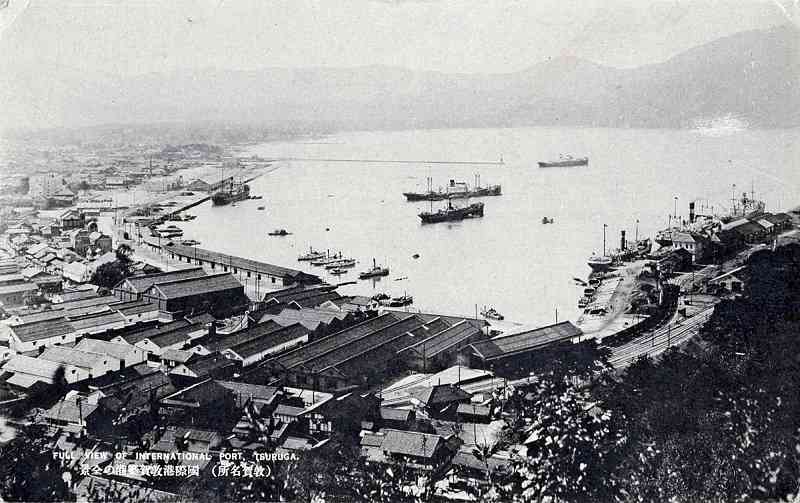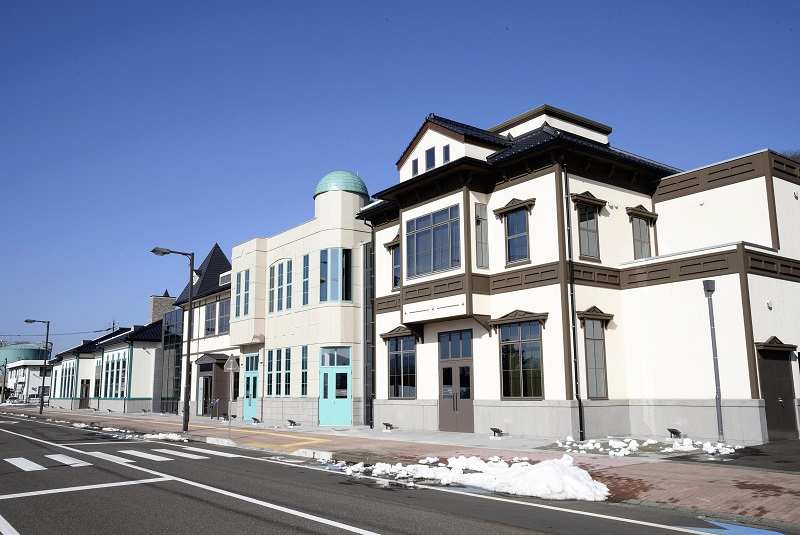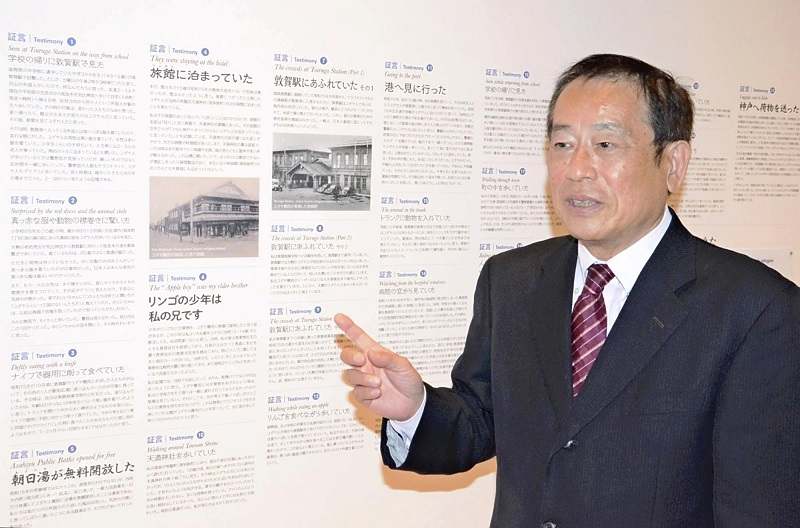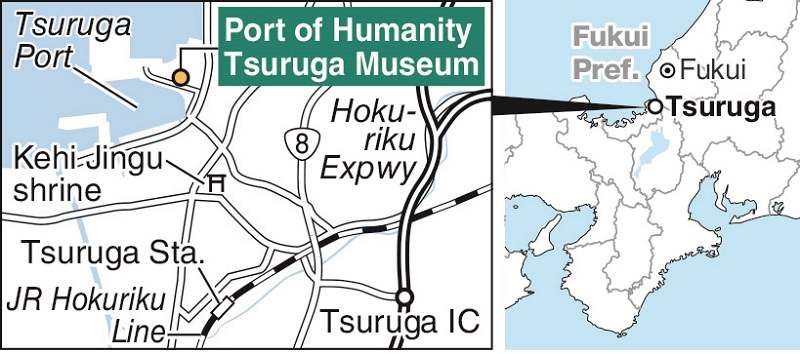
Tsuruga Port in the 1930s
11:01 JST, April 9, 2022
TSURUGA, Fukui — During World War II, Jewish refugees who escaped Nazi persecution were given a warm welcome by locals at Tsuruga Port in Fukui Prefecture. Today, a museum in the city is keeping memories of that period alive by sharing eyewitness testimonies.
Tsuruga Port flourished as an international stopping point following the opening of a shipping route between Tsuruga and Vladivostok, Russia, in 1902. The port connected to Tokyo by train, and many people would travel to and from Europe via the Trans-Siberian Railway. After using the railway to reach Vladivostok in 1940-41, the displaced Jewish people sailed across the Sea of Japan to reach Tsuruga Port.
Years before, Polish orphans had landed at the port in the 1920s. All alone, they had suffered from hunger and disease in the freezing climes of Siberia amid the turmoil triggered by the 1917 Russian Revolution. The orphans received help from the Japanese government and the Japanese Red Cross Society and were given medical treatment in Tokyo and Osaka. Later, they returned to their homeland via the United States or other countries.
The Jewish refugees who arrived in the 1940s were given “visas for life” by Japanese diplomat Chiune Sugihara (1900-1986), who worked at the consulate in Kaunas in Lithuania. It is said that the residents of Tsuruga were very hospitable toward the Polish and Jewish refugees.
Tracking down testimonies
The Port of Humanity Tsuruga Museum, which opened in 2008, exhibits testimonies from Tsuruga locals who remember the refugees’ arrival. One account notes that Tsuruga Station was full of displaced people. Another says a public bathhouse was made available to the refugees for free.

The Port of Humanity Tsuruga Museum
These and other interesting historical episodes were collected by members of a local historical society. However, few records exist about what happened to the refugees afterwards, and many residents know little about their arrival at the port.
“We wanted to clarify how local citizens were involved,” said Takaharu Furue, a member of the group. Furue, 71, explained that members had been actively collecting the testimonies since 2006. When they checked the various remembrances against an old city map, they were able to discover the route the refugees had taken to the station.

Takaharu Furue speaks at the Port of Humanity Tsuruga Museum in Tsuruga, Fukui Prefecture.
The group’s research began after a 1999 event commemorating the 100th anniversary of Tsuruga Port’s opening. As part of the event, Furue, who headed the secretariat for the occasion, exhibited a “visa for life” that had been kept in the town of Yaotsu, Gifu Prefecture, which had links to Sugihara.
Stories about the Jewish refugees generated a lot of attention, inspiring Furue to track down eyewitnesses to help “fill in the historical blanks.” To that end, he formed a research team with other group members and gathered 33 testimonies from 29 people.
The group also turned up a wristwatch that had been sold by a refugee in Tsuruga. It was in the possession of a woman whose father had owned a watch store in front of Tsuruga Station.
In 2006, Furue and his colleagues exhibited a number of the testimonies at the Tsuruga Railway Museum, situated in a re-creation of the old Tsuruga Port Station, the arrival and departure point for Europe. Though originally slated to last a month, the exhibition proved so popular it was extended several times.
Interest generated by the exhibition led to the opening of the Port of Humanity Tsuruga Museum, with Furue serving as its inaugural director.
Heavenly comparisons
Over the years, a number of former refugees and their descendants have visited Tsuruga.
In the autumn of 2020, some sent video messages to the museum expressing their gratitude toward Tsuruga, while apologizing for being unable to attend in person due to the pandemic.
One message from a former refugee said it was impossible to forget the kindness of the Tsuruga people, while another from a grandchild of a refugee said, “Thank you for welcoming my grandmother.”
Refugees recalled feeling a sense of security in Tsuruga, such as when watching their children freely running around outside, which had not been possible in their home countries. Some even compared Tsuruga to heaven.
“People at the ‘port of humanity’ treated the refugees with kindness,” Furue said. “I hope many people will learn about its history.”

‘Visa for life’
In 1940, Chiune Sugihara, a diplomat stationed in Lithuania, issued Japanese “visa for life” transit documents to several thousand Jewish refugees on his own initiative. Most of the refugees landed in Tsuruga before going to the United States and other countries via Kobe and Yokohama.
Sugihara was forced to leave the Foreign Ministry after World War II for issuing the visas without authorization. However, his reputation was reassessed after the Israeli government bestowed upon him the honorific title “Righteous Among the Nations” in 1985.
Countryside doctor saves life of woman
In the 1940s, a female Jewish refugee who had landed at Tsuruga Port was treated by an obstetrician and gynecologist in Tsuruga. The woman had suffered a miscarriage while aboard a ship from Vladivostok to Tsuruga while fleeing Nazi persecution.
The woman’s life was saved by a doctor who could speak German and Latin, the woman’s husband said in a newspaper article at the time. The husband said he had urged his wife to visit a doctor in Tsuruga.
A local historical society searched in vain for a first-hand account of this episode. Then, a few years ago, Keiichi Takeuchi, an 88-year-old man living in the city, realized that the doctor was his father, Takayoshi, who had run an obstetrics and gynecology clinic at that time.
Keiichi recalled that his father had learned German in high school and even remembered him speaking the language when calling on people. “I guess people couldn’t understand German, so he used Latin to explain things,” Keiichi said. “I hope they felt at ease being treated in the oriental countryside.”
The testimony of a woman who had worked as a nurse at Takayoshi’s clinic confirmed the positive identification. She said she had accompanied Takayoshi when he called on the Jewish couple at the inn they were staying at, and that Takayoshi had treated the woman following her miscarriage. “The couple looked sad and sorry,” the woman said.
It was later learned that the husband and wife were 39 and 30 years old, respectively, when they landed in Japan. They later left Tsuruga and headed to Kobe.
“My father was a stubborn but decent person,” Keiichi said. “He did his best as a doctor and would help anyone.”
Takayoshi and the nurse have since passed away. Keiichi, who was in the second grade at the time of the story, became an obstetrician himself and has been leading the historical society for five years. “My father contributed to the honor of our city, and Japan,” he said. I’m very proud of him.”
Related Tags
"Features" POPULAR ARTICLE
-

Sanrio to Open Museum in Yamanashi Pref. Dedicated to Founder, Exhibits Include Hello Kitty, Other Characters
-

Autumn Foliage Surrounds Visitors to Tokyo’s Showa Kinen Park
-

My Daughter No Longer Speaks to Me, But I Want to See Her and My Grandchild
-

Kumamoto: Public Bath Refurbished as Library Where You Can Chat, Take Photos
-

Frozen Vegetables: Demand Rises for Convenient, Tasty Domestic Produce
JN ACCESS RANKING
-

Tokyo Economic Security Forum to Hold Inaugural Meeting Amid Tense Global Environment
-

Keidanren Chairman Yoshinobu Tsutsui Visits Kashiwazaki-Kariwa Nuclear Power Plant; Inspects New Emergency Safety System
-

Imports of Rare Earths from China Facing Delays, May Be Caused by Deterioration of Japan-China Relations
-

University of Tokyo Professor Discusses Japanese Economic Security in Interview Ahead of Forum
-

Japan Pulls out of Vietnam Nuclear Project, Complicating Hanoi’s Power Plans

























